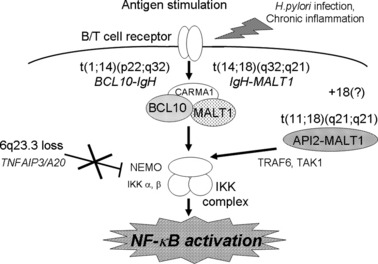Figure 6.

Shared function driving lymphomagenesis of variable genetic alterations. An indication of variable genetic alterations in the same disease entity was revealed by a series of studies on mucosa‐associated lymphoid tissue (MALT) lymphoma. Three kinds of chromosome translocations, t(11;18)(q21;q21), t(14;18)(q32;q21) and t(1;14)(p22;q32) were revealed as ALI2‐MALT1, IgH‐MALT1, and IgH‐BCL10, respectively. All of these translocations were found to deregulate signal transduction pathways to activate nuclear factor‐kappa B (NF‐κB). We have found that 6q23.3 loss is frequent in ocular adnexal MALT lymphoma and identified that the target gene is TNFAIP3/A20, which has a suppressor function on NF‐κB activity.( 34 , 35 ) The loss of TNFAIP3, therefore, would result in NF‐κB activation, indicating that the NF‐κB activation is essential for MALT lymphoma development. In this regard, 18 trisomy and chronic inflammation may work to activate NF‐κB.
